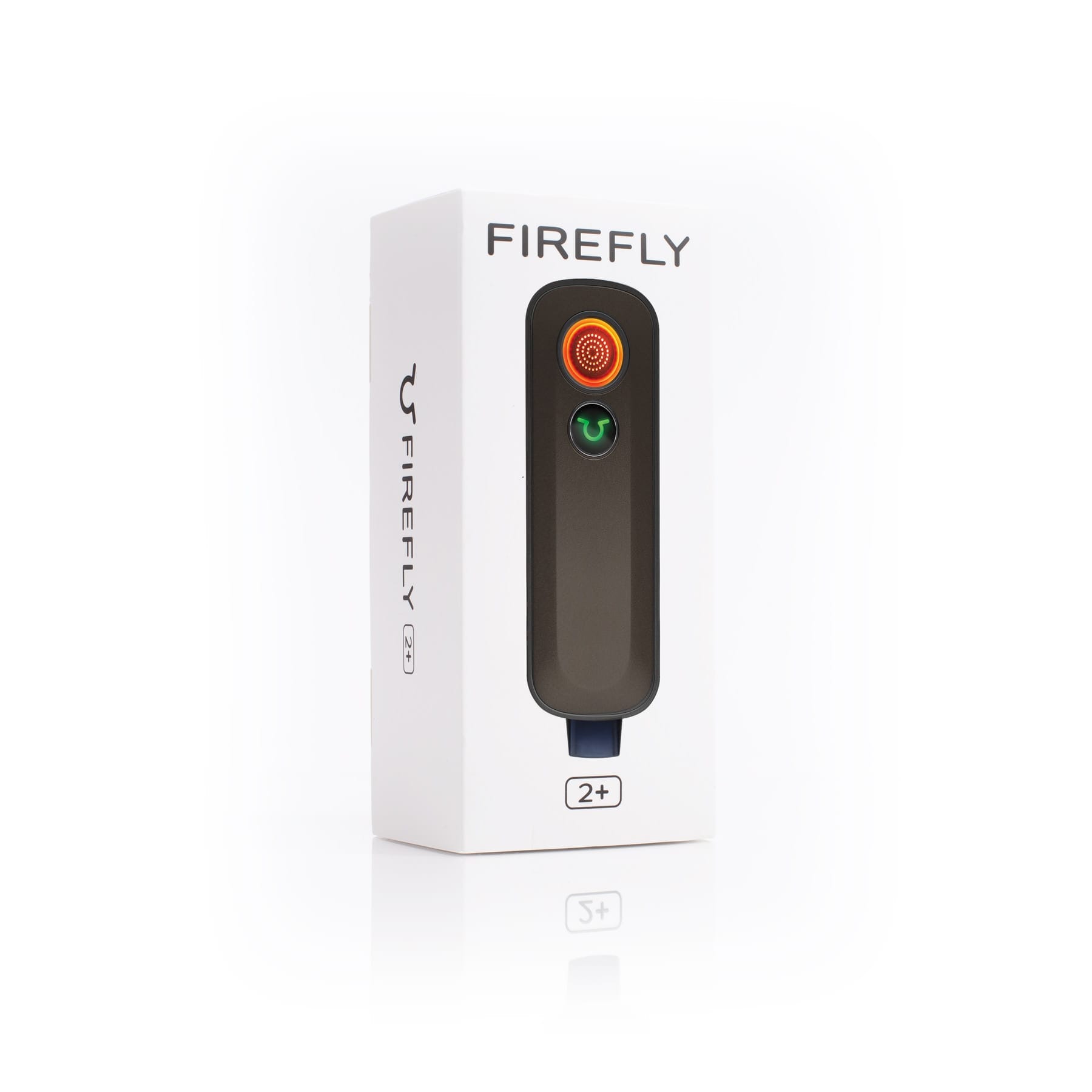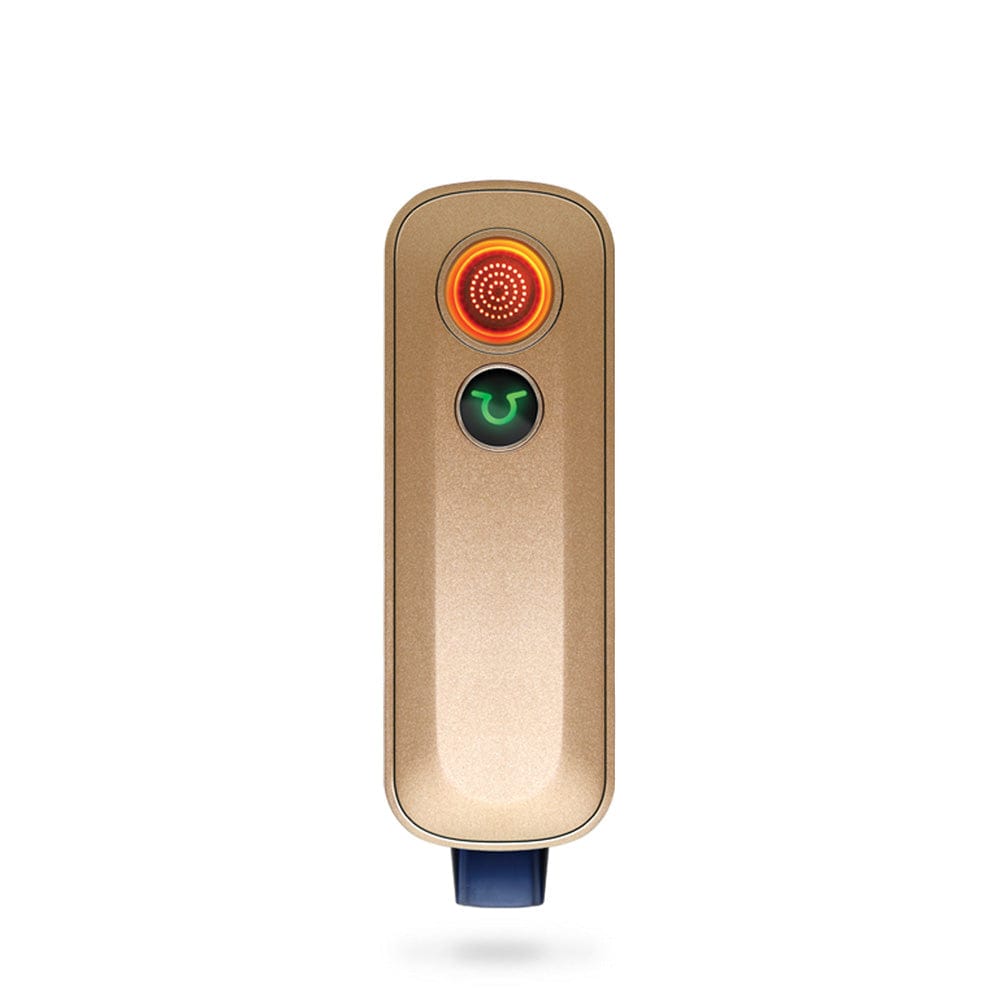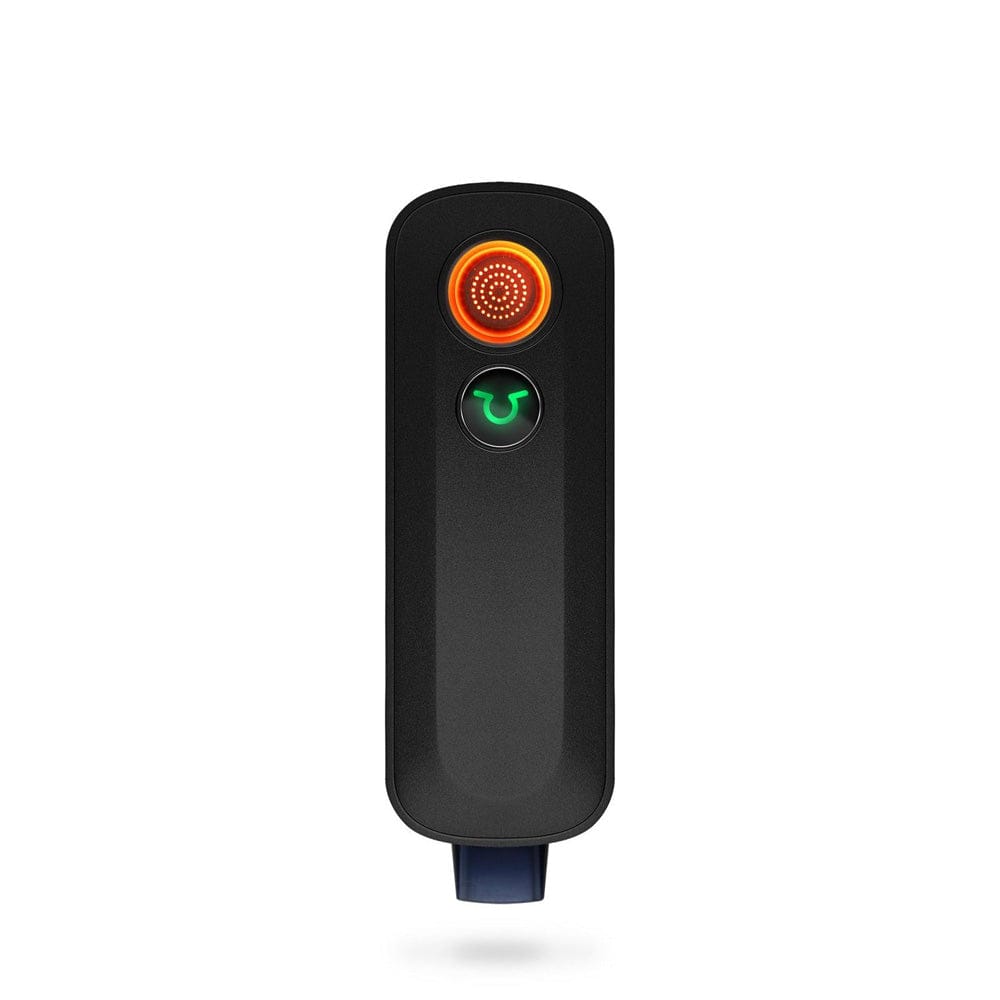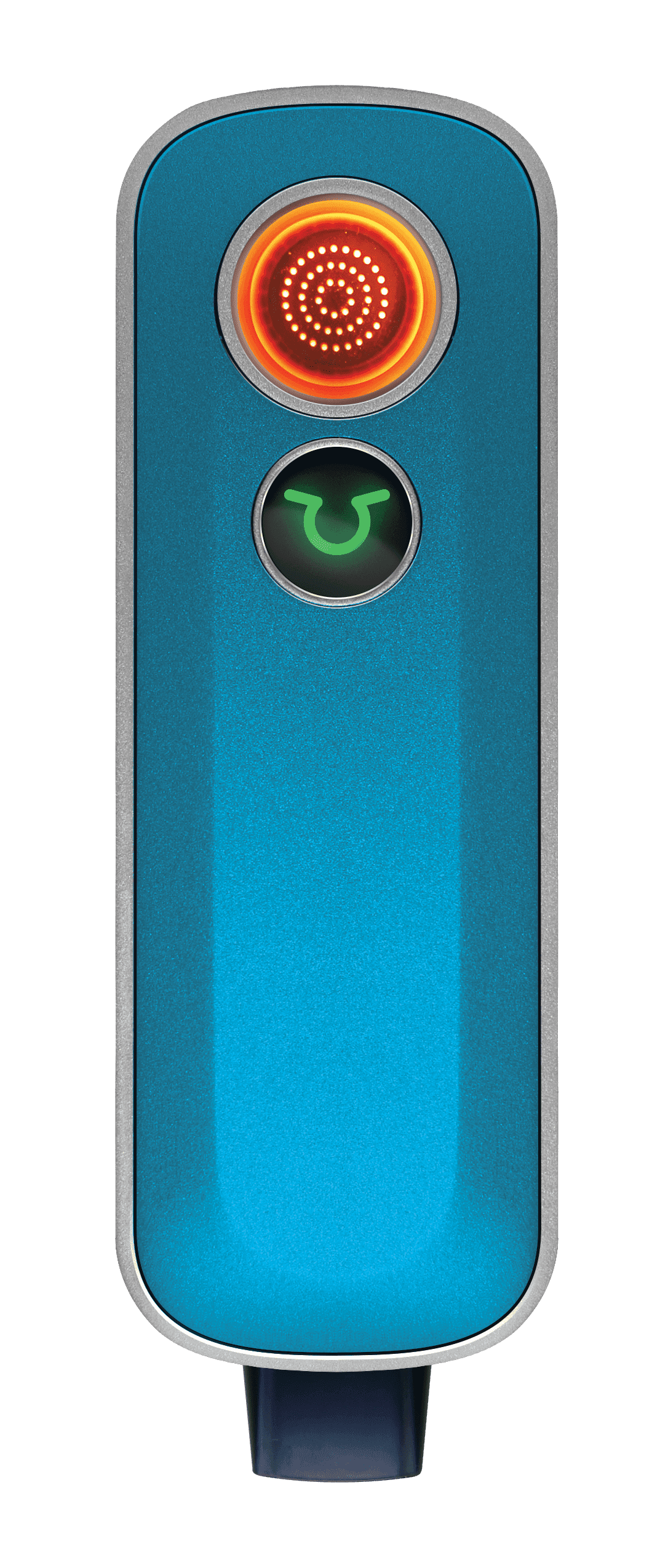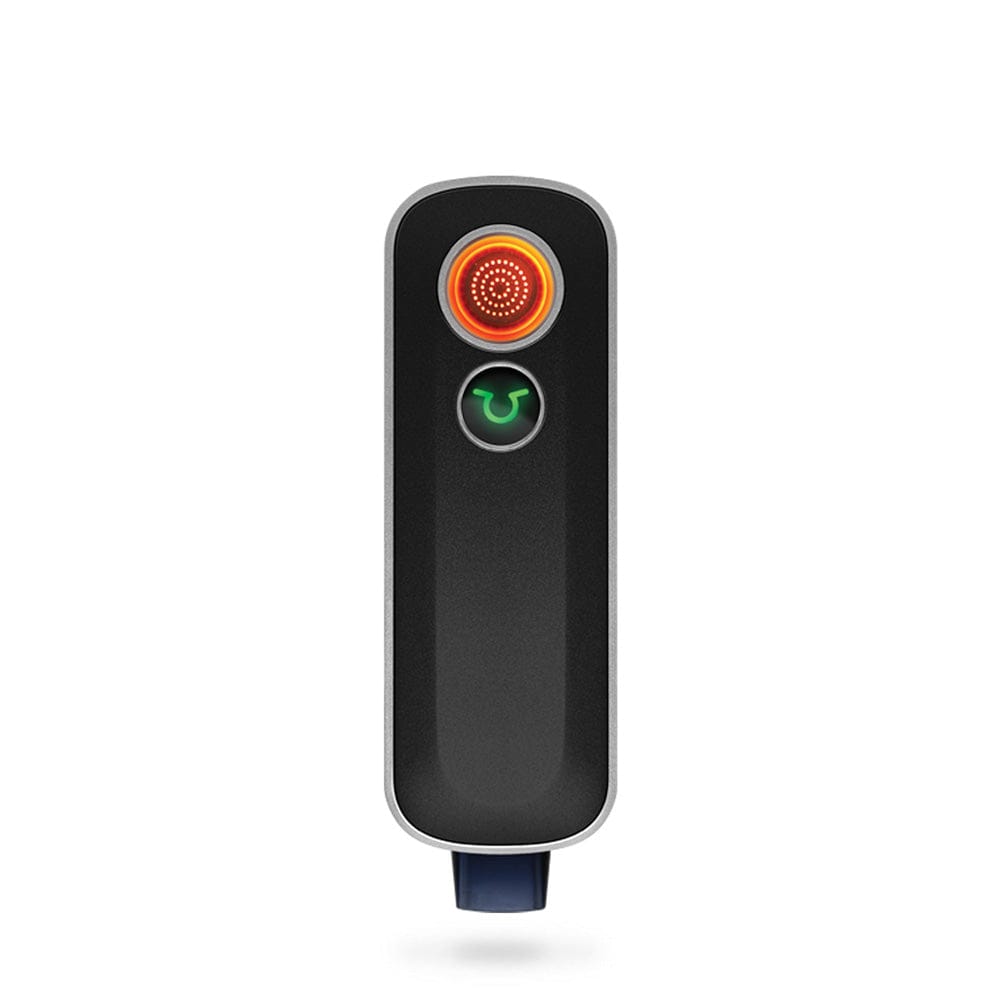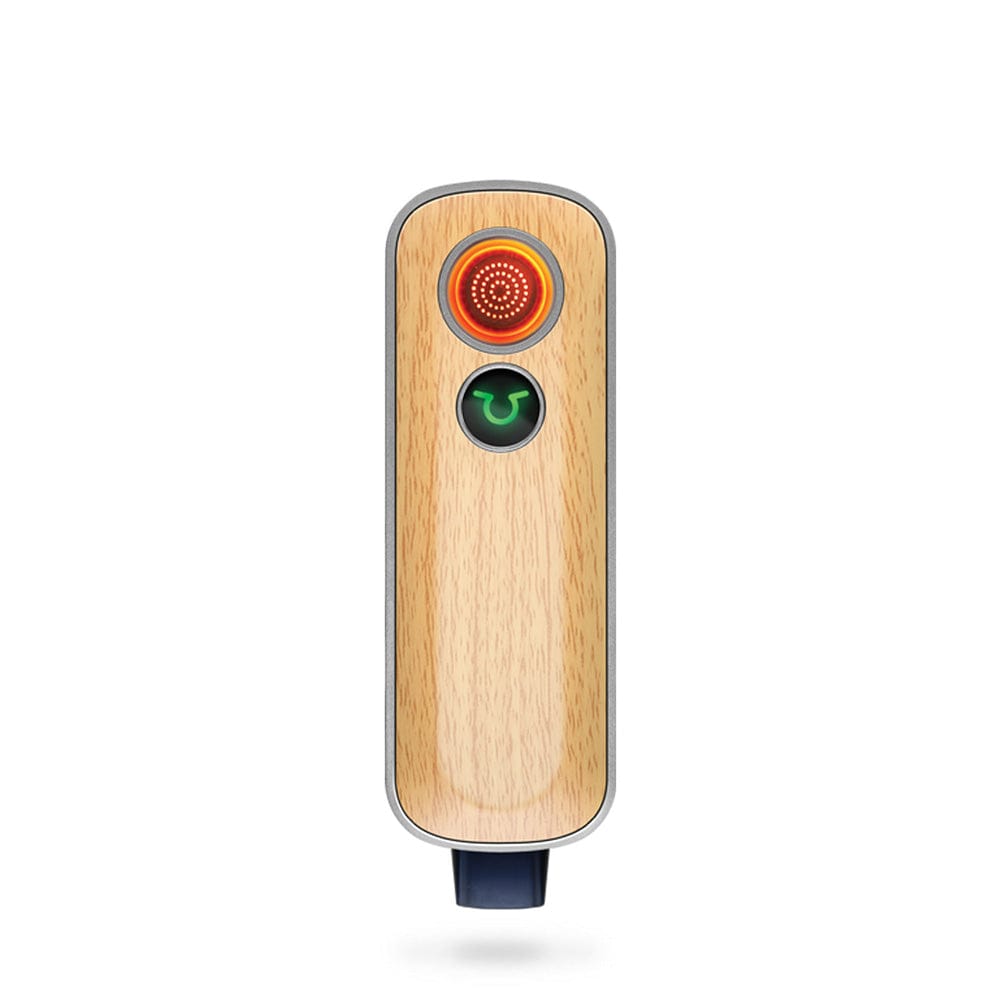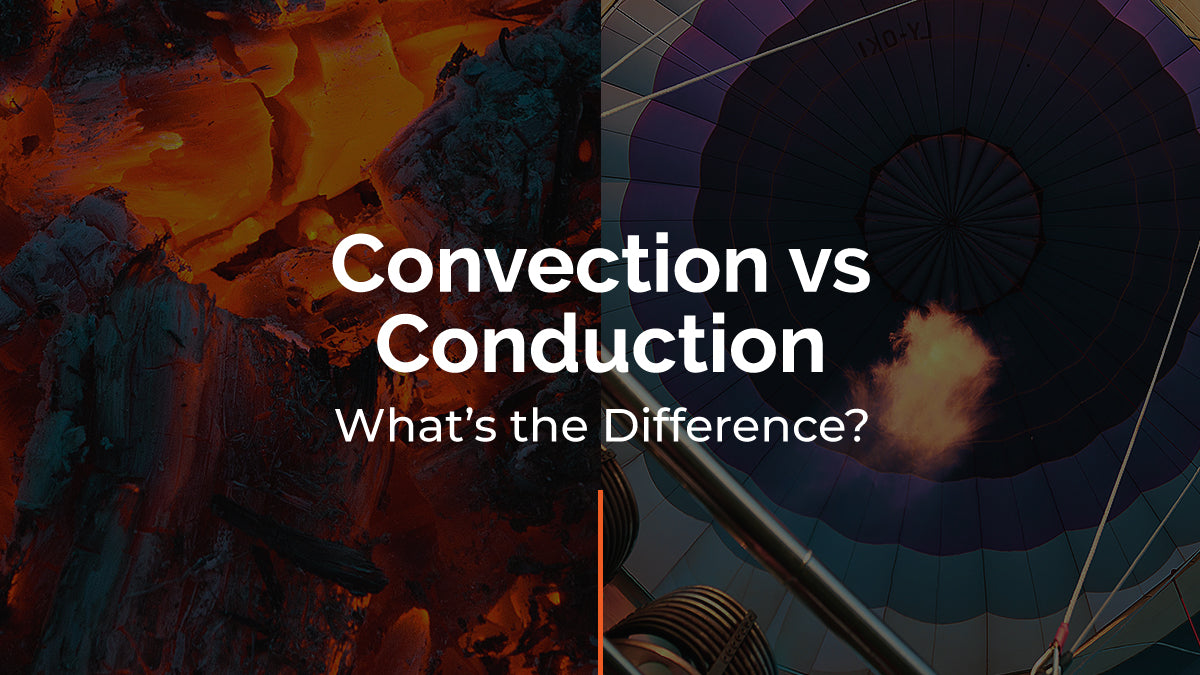
In this article we discuss:
- What is vaping?
- Are there any health advantages to vaping over smoking?
- Can vaping help quit smoking?
- Is vaping safe?
- Does a vape taste better than smoking?
- What are the different types of vaporizers?
- How to use a vaporizer
- What’s the best vape device for a beginner?
- Glossary of Vaping Terms

Vaping (short for vaporizing) is the act of inhaling vapors created by a vaporizer or e-cigarette. Vaporizers and e-cigarettes heat a substance without lighting it on fire in order to convert compounds from solids or liquids into an inhalable gas. Modern vaporizers can heat plant material, most commonly cannabis, but also other herbs used in aromatherapy. They can also heat essential oils, waxes, extracts and other liquids.
E-cigarettes are vaporizers that heat liquids which usually contain some combination of nicotine and flavoring agents as well as a thinner like propylene glycol, polyethylene glycol, coconut oil or vegetable glycerin. Vitamin E acetate, a seemingly harmless component of such thinners used in e-cigs, has been identified as the culprit behind vape related lung illness.


Vaping vs. Smoking
Inhaling smoke of any kind is dangerous to one’s health. Cigarette smoke contains over 7,000 chemicals and more than 100 of them are known to be poisonous or carcinogenic (cancer-causing). The toxic effects of cigarette smoke are no longer debated science. While cannabis smoke contains significantly less chemicals, it still contains considerable amounts of ammonia, tar, benzene and carbon monoxide – all considered toxic or carcinogenic. These harmful chemicals are a byproduct of combusting plant materials, and exist in the smoke created by lighting the plant on fire. As we will discuss later, vaporizing removes the need for such high heat and combustion, greatly reducing smoke and its associated dangers.
Can vaping help when quitting smoking?
Smoking is known to be a direct cause of many kinds of cancer including cancers of the lungs, mouth, throat, tongue, larynx, stomach, colon, pancreas, liver and blood (leukemia). According to the National Cancer Institute (NCI), most of the cancer-causing substances in cigarette smoke are in the tar. Tar also causes damage that can lead to lung obstructive diseases like emphysema and bronchitis. Nicotine alone does not have any of these harmful effects, which is why e-cigarettes are considered the most effective method to quit smoking cigarettes. They help the patient wean off nicotine addiction with none of the negative health consequences of smoke inhalation.
Smoking cigarettes also causes about a third of all heart disease deaths in the United States every year, according to the Surgeon General. As with cancer, nicotine isn’t a primary cause of acute cardiovascular events. The Surgeon General’s 2014 report says that “international epidemiologic evidence, and data from clinical trials suggests that chemical components in smoke other than nicotine elevates the risk of death from MI heart attack and stroke.” The oxidant chemicals, free radicals, particulates, and carbon monoxide from smoke damage the heart and circulatory system in many ways, according to the CDC. There has been no research to date showing any provable cardiovascular danger from vaping, largely because carbon monoxide is believed to be the biggest culprit in causing cardiovascular disease and vaping produces zero carbon monoxide.
The third major disease group that smokers face is, for many, the most frightening. Chronic Obstructive Pulmonary Disease (COPD) — which includes emphysema, chronic bronchitis, and non-reversible asthma — is a terrible thing to see. Patients may die gasping for air they’re unable to inhale because their lungs have stopped functioning. Smoking damages the lungs in several ways that can lead to COPD, according to the CDC:
- The airways and alveoli (tiny air sacs in the lungs) lose their ability to stretch and shrink.
- The walls between the alveoli are damaged and destroyed.
- The walls of the airways become swollen and inflamed.
- The airways produce too much mucus, which blocks air flow.
Particulates and the gasses within it are the cause of damage from smoking. The lungs try to fight the invading combustion products by producing mucus, but in heavy smokers they’re overwhelmed by the quantity of smoke, and eventually the mucus itself causes congestion and damage. COPD is progressive. In fact, it may continue to develop even after the patient quits smoking. And though there are treatments for the symptoms, there is no cure for COPD — except a lung transplant. There is no indication that vaping causes COPD or any of its associated disease groups (emphysema, chronic bronchitis, or non-reversible asthma).
On top of smoking’s long list of adverse effects on the health of internal organ function, it also significantly affects appearance. Most daily smokers appear to be aging faster because smoking deprives the body of oxygen and nutrients. In the skin, this causes skin spots, uneven skin tone, sagging skin, deepened wrinkles, loss of elasticity around the mouth and hair loss. Smoking also weakens and discolors the nails, hair, and teeth. Vaping has no known effects on appearance.
Despite negative side effects of smoking, cannabis’ cancer fighting powers have led many to continue smoking. A number of compounds in cannabis are proven to be anti-tumor and anti-mutagenic (cancer causing gene mutations). Such medical benefits are backed by a myriad of clinical studies and are generally not debated. For decades, cannabis activists have used this fact to argue for the legalized medical use of cannabis. However, the dangers of smoke as a method of cannabis consumption has often been left out of the medical conversation. Are the dangers of smoke inhalation mitigated by the cancer-treating and cancer-preventing properties of these compounds? There’s no clear answer, although the topic is being researched. Interestingly, a 2019 clinical survey revealed the general public to believe that cannabis’ benefits outweigh any negative effects of smoking. While researchers consider the risks vs benefits of smoking, medical doctors and cannabis scientists all agree this: Smoking cannabis releases the toxins ammonia, tar, benzene and carbon monoxide – all known to have devastating effects on human health. Vaping, on the other hand, allows a user to enjoy the benefits of cannabis without the risks of smoking.

Is vaping safe?
When compared to smoking, vaping is estimated to be 95% healthier, as noted in a 2017 study conducted by Public Health England in the UK. Vaping produces none of the aforementioned toxins. This has not meant that vaping has always been completely safe, however.
Over the 15 years that vaporizers and e-cigarettes have been widely available to consumers, some of the devices that companies produced were unsafe. For example, some cheaply-manufactured devices released nickel and chromium into the vapor path when their heating coils began to degrade.
Another concern is reports of some e-cigarettes exploding, causing injury and even death. What causes a vape device to explode? Identified as the foremost cause is user modification of the device. Known as “mech mods” or “mech mod vapes,” these devices are sold with the intention of the user being able to modify by altering, adding or removing components. Another cause is the degradation of lithium-ion batteries, which can catch fire when improperly used or stored.
The FDA recommends the following for safe vaping:
- Follow manufacturers’ instructions.
- Don’t remove or disable safety features.
- Only use recommended batteries, and avoid mixing battery brands and charge levels.
- Charge the battery on a clean, flat surface and where it cannot overheat.
- Protect the device from extreme temperatures, such as direct sunlight or a cold car overnight.
- Be sure to properly pack when traveling.
In addition to proper use, it’s important to only use a quality device from an established and trusted brand.
Health benefits of vaping cannabis.
Vaping cannabis has another significant health benefit versus smoking it. All the active ingredients in cannabis fall under two phytochemical categories: terpenes and cannabinoids. Many of these compounds can exert extremely strong effects that are beneficial to health. However, when cannabis is smoked, many of these beneficial compounds are lost. When cannabis is vaporized, however, the user can access the full spectrum of terpenes and cannabinoids available from the plant.

Cannabinoids: Cannabinoids are plant-based chemicals found in a wide variety of plants, including cannabis flowers, proven to be effective in treating human ailments ranging from pain, nausea, anxiety, inflammation and many other symptoms, conditions and diseases. They are effective because they stimulate the body’s endocannabinoid system which naturally regulates the body’s various internal systems, such as the immune system, nervous system, endocrine system, and digestive system. Cannabis contains more than 85 different cannabinoids that all have a different suite of effects on the body, and researchers are still discovering even more.
To learn more about cannabinoids, read our article, Everything You Need To Know About Cannabinoids.

Terpenes: Terpenes are fragrant oils secreted by herbs, fruits and plants that give them their distinct aroma profiles. Cannabis flowers produce the widest range of terpenes of any plant, numbering more than 100. They are secreted in the same resin glands on the flower that produce cannabinoids. Like cannabinoids, terpenes bind to receptors in the brain and have a wide variety of effects on the body’s systems.
To learn more about terpenes, read our article, A Guide to Terpenes.
While it’s clear that vaporizing offers advantages to traditional smoking, it’s important to also note that many vaporizers overheat cannabis to the point of combustion. This defeats the purpose of a vaporizer, making it little more than a smoking device. With this in mind, it’s important to weigh out a vaporizer’s features, which we discuss later on.
Unique benefits of inhaled cannabinoids
Since cannabis’ benefits can be enjoyed in a variety of ways (such as edibles), why even consider vaping and smoking? The body processes cannabis in different ways depending on how it’s consumed, and it turns out that inhaled cannabis has some unique benefits.
One is that inhaled cannabis is the fastest route of administration, with discernible effects in only seconds. Edibles, on the other hand, take at least 30 minutes to feel. Quick absorption and quick results is the number one reason people choose to vape cannabis. Another unique benefit is that inhaled cannabis interacts more profoundly cannabinoid receptors within the brain and central nervous system. Researchers have discovered that inhaled cannabis is the most effective for easing nerve pain, as well as the best method for when used with conditions such as ADHD and depression.
Vaporizing cannabis let’s consumers take advantage of these benefits and conveniences without the negative side effects of smoking.

Taste
When cannabis is ignited with fire, many of the terpenes that give cannabis its unique flavor, smell and effects are destroyed. Terpenes are the plant kingdom’s biochemical building blocks of smell, and the sense of smell is intrinsically linked to taste. Thus, terpene preservation (and proper activation) is the key to delicious flavor when vaping. In contrast to smoking which destroys flavorful terpenes, vaporizing can maximize these flavor profiles.

Every strain of cannabis has a different cocktail of the 100+ terpenes that are found in cannabis. These various combinations of terpenes give cannabis its delightful aromas like pine, citrus, floral, earthy, skunky, cheesy, woody, etc. Vaping cannabis allows the user to experience the most delicate aromas and tastes in a handful of first hits. After these terpenes are vaporized into the user’s lungs, many terpenes and cannabinoids remaining in the plant may have a different flavor profile. Some people compare the “second wave” of taste to a buttery, toasted popcorn taste, or perhaps a rich and creamy peanut butter, all depending on the strain. The remainder of hits produces these nuanced flavors until all the terpenes and cannabinoids in the plant material have been vaporized. At this point, no more vapor can be produced, however the most flavor possible has been extracted from the entire plant material or concentrate. This is one reason vaporizing is the most efficient way to consume cannabis (a point we delve into a bit deeper later on). Smokers thus miss out on many delightful tastes that can only be accessed through vaporizing. To learn more about the experience of terpenes in cannabis, read, A Guide to Terpenes.
Discretion
Since smoke is easily smelled and seen, many prefer vaping for its discretion. Exhaled vapor dissipates within a few seconds and afterwards cannot be easily detected by smell or sight. Many vaporizers, vape pens, and e-cigarettes look like everyday household items or electronic devices, so users often go unnoticed when they are vaping. Vape pens and e-cigarettes are particularly difficult to distinguish from other items. These devices do not carry strong scents the way that smoking-related paraphernalia do, so users can vape in a variety of ways and places without being observed.
Clarity
In addition to aroma and taste, terpenes and cannabinoids all have strong psychological and physiological effects. Some of these effects include making users feel alert, energized, focused, aware, thoughtful, creative or social (to name a few). However, when so many terpenes and cannabinoids are destroyed by burning at the extremely high heat of flames, the user does not always get to experience these effects. Instead, they may only feel the effects of the terpenes and cannabinoids with higher “boiling points,” which have more resistance to the high heat of smoking.

Because of this, many users report being more alert, aware and clear-headed when they vaporize cannabis versus when they smoke it. It’s not because less terpenes and cannabinoids are being delivered. Rather, it’s because more are being delivered, and they all affect the user’s experience. When cannabis is smoked, users often miss out on this symphony of effects, instead feeling the singular experience of a more incapacitating high.
Dosing
Additionally, vaping allows much more precision in controlling their dosing. This empowers users to prevent being over-affected and maintain more clarity during their experience. As more and varied benefits of terpenes and cannabinoids are discovered, cannabis expands in its use. Many now use cannabis as part of their daily routine, as a wellness enhancer, and to boost creativity and sharpen focus. Many have discovered microdosing to achieve their desired effect, and vaping makes controlling the does (and experience) much easier.

Use Less Get More
When cannabis is lit, immediately over 60% of the terpene and cannabinoid are lost. Furthermore, since the cannabis remains combusting before and after every hit, a considerable amount of cannabinoids and terpenes go up in smoke...literally.

When the same quantity of cannabis is vaporized, however, the user gets to enjoy substantially more of the usable content. The best vaporizers make over 90% of the plant’s terpenes and cannabinoids available. Others vary in their efficiency, but one certainty is that vaporizing gives users significantly more terpenes and cannabinoids than smoking – usually more than double. Because less cannabis is needed to achieve desired effects, vape users unanimously report consuming much less cannabis by weight than they did when they were smoking.
While different vaporizers have different levels of efficiency, the Firefly 2+ is considered the most efficient vaporizer on the market. Most daily Firefly users report cutting the quantity of their cannabis consumption by as much as 75% when they switch from smoking.
Pure Plant Experience
Many go to great lengths to consume the finest quality cannabis they can find. The qualities they seek in the finest cannabis include rich smell, delicious taste, and potent effects. These factors are derived from the unique recipe of terpenes and cannabinoids found in each strain. Since vaporizing delivers substantially more terpenes and cannabinoids than smoking, users are able to experience a more authentic and pure experience from the plant. Thus, “canna-soeurs” who care about getting the most from quality cannabis usually prefer vaporizing.
Cost Efficiency
Since most users buy their cannabis instead of growing it, price matters. Daily consumers who switch from smoking to vaping usually report cutting their cannabis costs by at least 50%. The most efficient vaporizer (such as the Firefly 2+) is reported to allow users to reduce cost by 75% or more. Using less cannabis to get more powerful effects means vaporizers quickly pay for themselves in savings.
Curious how much vaporizer could save you?


Tabletop and Portable
The first vaporizers invented, tabletop (also called “desktop”) vaporizers must be plugged into a 12 volt wall socket and are generally much too large to transport easily. Portable vaporizers are much smaller, usually small enough to be transported fairly easily in pockets or bags. Most portable vaporizers are powered by rechargeable batteries and need to be plugged into a 12 volt wall socket to recharge.
Convection Vaporizers
The highest rated vaporizers all use convection heat. These vaporizers work like a convection oven: hot air surrounds the herb or concentrate without any direct contact with the heating surface. Convection vaporizers typically have air intake vents. Air is drawn into these vents, then heated by the heating mechanism. The hot air then passes through the herb or concentrates in the device’s bowl. Desired compounds, such as terpenes and cannabinoids, separate from the plant material without burning, boiling off to create a pure vapor which is then inhaled.

There are very few pure convection vaporizers on the market. The Volcano by Storz & Bickel, the VapeXhale, and the Herbalizer are all desktop plug-in vaporizers. The Grasshopper and Firefly 2+ are the only portable pure convection vaporizers currently made.
The Firefly 2+ takes convection to an entirely new level with its unique Dynamic Convection technology. With Firefly 2+, the air in each draw gradually increases from room temperature to the user-set peak temperature. This unique feature captures each terpene and cannabinoid despite their varied boiling points. Other convection vaporizers only heat at a single temperature
Whereas the other convection vaporizers send air at one single temperature, the dynamic convection of the Firefly 2 allows each different terpene and cannabinoid to boil into vapor at its unique boiling point.
To read more about the difference between convection and conduction, read Convection vs. Conduction: What makes the best vaporizer?
What are boiling points and why are they important?
Boiling points are important to understand when vaping. To inhale cannabis, it must be heated enough so that the active ingredients (terpenes and cannabinoids) are transformed from a liquid or solid into a gas. A compound’s “boiling point” is the temperature at which this transformation happens. This is important because each different terpene and cannabinoid has its own unique boiling point, which vary widely from as low as 198° F all the way to 447° F.

When compounds with low boiling points are exposed to high heat, they are severely damaged and many of them are lost. Igniting cannabis with flame loses more than 60% of the terpene and cannabinoid content in the plant! That means that when cannabis is smoked, more than half of both the flavor and effects are destroyed. However, while using a vaporizer saves these precious compounds, that alone doesn’t mean one is getting the most out of their cannabis.
Since each terpene and cannabinoid boils into gas at a different temperature, the optimal method for vaporizing cannabis is to heat it at a gradually increasing temperature scale. Only one vaporizer on the market is capable of this process – the Firefly 2+. All other vaporizers (even the most expensive ones) heat the cannabis or extracts by exposing it to heat at one high temperature. While that temperature is less than a flame and therefore still healthier and more efficient than smoking, the single high temperature still causes many of the terpenes and cannabinoids with lower boiling points to be destroyed by overheating. The Firefly 2 is the only vaporizer capable of heating each terpene and cannabinoid at its own unique boiling point temperature.
Conduction Vaporizers
Whereas convection vaporizers surround the herb or concentrate with hot air in order to heat it, conduction vaporizers heat the herb by touching it to a hot surface. Heat is then transferred (or conducted) from the hot surface to the herb. Conduction is a less efficient and less precise method of heating than convection. In order to heat the bulk of the herb, the surface must get so hot that the layer of herb touching the hot surface burns. This burning generates small amounts of smoke into the vapor, while inconsistent heat patterns create uneven vapor paths.
The best conduction vaporizers utilize a combination of convection and conduction heat. They don’t extract Terpenes and Cannabinoids at the same ultra-high efficiency rates as the pure convection vaporizers. But they do a significantly better job than pure conduction vaporizers. Conduction vaporizers tend to be less expensive than convection vaporizers because they are mechanically simpler and can be made with fewer and cheaper parts. The more expensive conduction vaporizers are often over-priced for their quality of performance.

The highest rated combination convection/conduction desktop vaporizers are the Plenty from Storz & Bickel, the E-Z-Vape and the DaBuddha. The top portable combination vaporizers are Mighty and the Crafty from Storz & Bickel, the G-Pen Elite by Grenco Science, the Solo and the Air from Arizer. The top pure conduction vaporizers are Davinci IQ, Pax 3 and Magic Flight Launch Box. They are all portable vaporizers.
Most conduction vaporizers are portable and utilize electric heat from rechargeable batteries. There are a few desktop conduction vaporizers which require a 12 volt electric outlet for power. They use electric heat to heat up the hot surface that touches the herb or concentrate. The herb is then heated to vapor temperature which releases Terpenes and Cannabinoids into the inhalable vapor path.
Oil Pen Vaporizers
Some vaporizers are dual use, meaning they can vaporize dry herbs or concentrates, oils, extracts, etc. Other vaporizers are exclusively for oils, concentrates and extracts. These are generally called oil pens or vapor pens, even if some of them vaporize substances other than oil (like rosin, wax, etc.). Vapor pens are generally the easiest to use, most portable and discreet vaporizers available. They can be preloaded or refillable. The preloaded pens require very little effort – merely press a button and inhale.
There are multiple types of preloaded pens. Many products come in cartridges that are designed with a “510-threaded” standard vaporizer format, a standardized threading format which is very common. (To learn more about 510 threaded batteries read, Four Reasons People Love 510-Thread Vape Batteries) Reusable devices include a main pen atomizer system that gets recharged while oil-filled cartridges are removed and replaced. Since most pen batteries are made with 510 threading, most pen devices and cartridges are interchangeable.
Some preloaded vape pens are sold as disposables. These pens come with pre-charged batteries that allow use of the device until the tank of oil or other concentrates empties. They do not require any charging and don’t have removable or replaceable parts. Single-use devices are designed to be disposed of after their use, making them ideal for trying cannabis for the first time or exploring new strains and flavors.
There are many different types of oils, concentrates, and extracts used in vapor pens. These substances vary in potency, effects, flavors, and processing techniques used to create them. E-Cigarettes are just vapor pens filled with oils that contain some combination of nicotine and flavoring agents as well as a thinner like propylene glycol, polyethylene glycol, coconut oil or vegetable glycerin. Before trying a vapor pen, users should research the ingredients and reputation of what they are interested in trying. Likewise, cannabis cartridges can be made with various ingredients and induce a number of effects. To ensure an enjoyable and safe experience, be sure to select a well-reviewed cartridge and device from a reputable manufacturer.
To explore everything you need to know about vaping with a pen device, including how to ensure safe ingredients and how to shop for the best device and cartridges, read…(Link to O.pen blog)

Vaporizers are generally easy and intuitive to use. For the best experience, be sure to follow the manufacturer’s instructions on use, cleaning, and troubleshooting. Following is a series of videos demonstrating how easy it is to use the Firefly 2+ vaporizer.
How to pack a vaporizer
How to use concentrates:
How to inhale with a vaporizer:
Troubleshooting airflow problems with a vaporizer:
How to clean a vaporizer:
What’s the best vape for a beginner?
With so many options, it can be overwhelming for beginners to choose their first vaporizer. Here’s a helpful guide to the decision process.


510 – The industry standard metal threading size for the vast majority of replaceable cartridge vaporizers, atomizers, and batteries.
Absolute – A cannabis concentrate or extraction that has been completely purified by removing all the waxes and fats.
Airflow – The amount of air flowing through a vaporizer or atomizer with each puff. Usually more airflow creates a larger amount of vapor.
Amps (amperage) – A unit of measurement of electrical current flowing along a circuit. Most portable vaporizer batteries are measured in milli aMh which is 1/1000th of an amp. Batteries with higher amperage are better suited to power atomizers with lower resistances without overheating.
Atomizer – The main component of a portable vaporizer that houses the heating element (usually a coil and wick). The heating element is heated to turn liquids or concentrates into vapor.
Automatic Shutoff – A safety feature which exists in many e-cigarettes and vaporizers – portable and desktop – to prevent the battery and unit from overheating.
Battery – Powers the heating element of a vaporizer. With some vapor pens and portable vaporizers, the battery can be removable. Others may be permanently attached within large desktop vaporizers and some rechargeable portable vaporizers. Most portable batteries use lithium polymer or lithium ion technology.
BHO – Butane Hash Oil. BHO is a cannabis extraction method which uses butane as a solvent to remove the terpenes and cannabinoids from a plant. The resulting mixture is then processed in various ways to create an oil that can be vaporized.
Boiling Point – The specific temperature at which a substance boils from liquid into gas state. The 180+ terpenes and cannabinoids found in the cannabis plant all have unique individual boiling points.
Borosilicate Glass – A type of heat-resistant glass made from boron and silica.
Cannabinoid – A term encompassing over 100 phyto-chemicals produced in the resin glands of the cannabis plant. Many plants produce cannabinoids, not just the cannabis plant. Cannabinoids interact with the human body’s endocannabinoid system which regulates many of the body’s other systems such as the nervous system, immune system, digestive system, and circulatory system.
Carcinogen – Any substance known to cause cancer in living tissue.
Cartridge – An atomizer attached to a tank made of glass or plastic which is pre-filled with cannabis oil or e-liquid. Most cartridges are disposable and there are innumerable companies manufacturing cartridges.
CBD – An acronym for the cannabinoid called Cannabidiol, which has a large and varied amount of medicinal properties including anti-seizure, anti-inflammatory, antioxidant, and analgesic.
Ceramic Coil – A type of coil using ceramic instead of metals, which makes the coil last longer and creates more flavorful vapor.
Clouds – Visible cloud-like vapor from a vaporizer.
Cloudchaser – A vape user who needs to create large vapor clouds in order to feel like they are effectively vaping.
Coil – The heating element within an atomizer that heats the oil or liquid, causing it to vaporize. Not all atomizers use coils, but it is the most commonly used heating element. Others may use multiple coils.
Combustion – A heating method that burns what it is heating, causing smoke and not vapor.
Concentrates – Potent substances derived from cannabis. There are many types of concentrates including but not limited to oil, wax, crumble, shatter, rosin, resin, et al.
Conduction – A heating method that conducts heat between two surfaces. It requires a heating element to be touching the surface of the substance that is intended to be heated, usually cannabis flower, concentrates, or e-liquid. Conduction is considered an inefficient heating method compared to convection.
Convection – A heating method that does not make direct contact with the substance. Instead, the heating element heats air and sends the hot air through the vaporizable substance. Convection is considered significantly more efficient than conduction for vaporizing.
Dab (dabbing) – “Dab” is used as both a noun and a verb. As a noun, it refers to a dose of concentrated cannabis extract like wax or shatter. As a verb, it refers to the act of heating a heating element, often called a nail, then applying the dose of concentrate to the heated nail and inhaling the vapor that is instantly created. Dabbing is considered one of the most efficient methods to ingest a high dose of cannabis.
Desktop Vape – A non-portable vaporizer designed for home use, which usually requires being plugged into a 12-volt wall outlet for power.
Dry Burn – Heating of an atomizer without any liquid or oil present in order to clean the coil.
Dry Hit – A pull from a vape pen or e-cigarette that is out of oil or liquid.
Dual Coil – refers to an atomizer that has two separate coils instead of one. Dual coil atomizers usually take more battery power and reduce battery life, but they produce more vapor.
Dynamic Convection – Firefly’s unique heating method in which convection-heated air is passed through a vaporizable material at steadily increasing temperatures, allowing all the compounds to boil into vapor at their individual boiling points.
E-Juice – Also called e-liquid, refers to the solution in e-cigarettes and nicotine vaporizers. Different solutions contain different concentrations of nicotine and flavorings as well as excipients like Propylene Glycol, Polyethylene Glycol, or Vegetable Glycerin.
E-Cigarette – The vaporizer apparatus combines an atomizer and battery to vaporize an e-liquid containing nicotine.
Flower – The buds of the cannabis plant which are ground up then consumed by combustion or vaporization. Cannabis flowers contain significant amounts of terpenes and cannabinoids, which are the active ingredients in cannabis.
Formaldehyde – A carcinogenic compound that can be created by certain types of vaporizer components when the atomizer components are subjected to extreme heat.
Fractional Distillation – Also called short-path or molecular distillation, fractional distillation is an extraction method used to separate the various active compounds in the cannabis plant from each other. Distillate concentrates are visibly clearer than other concentrates and have very high potency, often over 90%.
Hash Oil – A thick, viscous concentrate made by dissolving hash or cannabis flower in a solvent, creating a potent concentrated liquid.
Heat Up Time – The amount of time it takes for a vaporizer to warm up and be ready for use.
Heating Element – The part of the atomizer that heats up and vaporizes. Heating elements can be made with a variety of methods and materials.
ICR – Stand for “Lithium Ion Cobalt Rechargeable” battery.
IMR – Stands for “Lithium Ion Manganese Rechargeable” battery.
Inhale – Breathing vapor into your mouth and lungs.
Leaking – When liquid or oils leak out of the atomizer cartridge or tank. Leaking can be dangerous if it leaks into the battery.
LED – An acronym for “Light Emitting Diode.” Many vaporizers and e-cigarettes use LED lights to indicate that the device is operating.
Lithium ion –A type of high-quality rechargeable battery. They can be made in various shapes, sizes and capacities.
Li-Po – “Lithium Polymer Rechargeable” battery.
mA – A unit of measurement equaling 1/1000th of an amp
mAh – An acronym for “Milliamperage Hour” which is a unit of measurement for a battery’s capacity to store electricity. When the mAh is higher, the battery can store more energy before requiring a recharge.
MCT – An acronym for “Medium Chain Triglyceride” and is a substance frequently used as an excipient in cannabis extracts to give them a smoother viscosity.
Microprocessor – A tiny computer chip which communicates with the battery and atomizer, allowing for a higher level of customization.
mg – The abbreviation for milligram, the unit of measurement of mass most commonly used to indicate the potency of both cannabis and nicotine vaporizable substances
Mouthpiece – The part of a vaporizer from which the user inhales.
Nail – Also called plates or hot plates, the nail is used for conducting heat when dabbing cannabis extracts.
Nichrome – The combination of Nickel and Chromium that are commonly used in wires within atomizer coils.
NiMH – An acronym for “Nickel-Metal Hydride,” a type of battery containing no cadmium and no memory effect, which makes charging a battery easier.
Ohm – The unit of measurement used to measure electrical resistance. Lower resistance allows for faster heating.
On-Demand Vape – A vaporizer that has a very short heat up time.
Organic Cotton – A specific type of wick used in some atomizers and tanks. Organic cotton wicks burn quicker than silica wicks but give cleaner, more flavorful hits.
Pass-through – When a device is capable of being used while it’s charging or connected to an external power source.
Polyethylene Glycol (PEG) – A polyether compound used in many pharmaceutical products. It can be added to e-liquid or cannabis oils as an excipient to adjust viscosity.
Propylene Glycol (PG) – Used similarly to Polyethylene Glycol as an excipient, PG is often found in food processing.
Primer – Also called “Primer Liquid,” a vegetable glycerin based solution often used on coils and wicks of atomizers to prevent over-drying during shipping or storage.
Priming – The act of taking a few puffs on a vaporizer to get it ready for a full puff.
Puff – The act of taking a draw from a vaporizer using the mouth to create suction.
Pull – A term for inhaling or drawing on a vaporizer.
Quartz – Found in crystal or glass and often used when making dab rig nails or rods in atomizers which can take the place of coils.
Resin – A tar-like residue on the cannabis flower concentrated with terpenes and cannabinoids.
Resistance – The rate that electrical current runs through the heating element. High resistance uses more electricity and heats slower.
Resistance Wire – A special type of metal wire used to make coils upon which liquids and oils can be heated to be turned into vapor. The amount of resistance in the wires can impact the amount of vapor and its flavor.
Rosin – A type of cannabis concentrate manufactured by heating and pressurizing raw cannabis flowers to create a thick, viscous sap. Rosin is solvent-free and offers a high fidelity to the exact compounds and their concentrations in the plant itself.
Session Vape – A vaporizer that can be used for many back-to-back hits, allowing for a “session.”
Shatter – A type of cannabis concentrate known for its brittle texture that shatters after lightly drying.
Silica – The most commonly used substance for atomizer wicks because it has a high melting point temperature.
Solvent – A group of compounds used to dissolve other substances. Terpenes and cannabinoids from a cannabis plant are often dissolved into a variety of solvents before processed into a consumable extract or concentrate.
Solvent-free – An extract or concentrate in which there are no solvents. Some concentrates can be made using solvents, but then all the solvents are removed rendering the substance solvent-free. Other methods (like pressing rosin) don’t use solvents at all.
Standard Resistance – The most commonly considered safe range of Ohm levels for vaporizer devices, usually between 1.8-3.0 ohms.
Steel Mesh – A formation of steel mesh used to build atomizer wicks.
Sub-ohm – A vaporizer set to a coil resistance below 1 ohm.
Sweet Spot – A slang vaping term referring to the best settings and techniques that a user may find with their individual vaporizer device after a period of trial and error.
Tank – The component of an atomizer, often made of glass or plastic, that contains the oil or liquid to be vaporized.
Terpene – The second of two categories of active phyto-chemicals present in the cannabis plant. Terpenes are delicate compounds that comprise the plant kingdom’s building blocks of aroma. Terpenes interact with the body’s systems, much like cannabinoids, and are the active ingredients in aromatherapy as well as essential oils. There are over 80 Terpenes found in the cannabis plant, all with different boiling points.
Vape Pen – A term generally used for a specific type of vaporizer with an atomizer and battery in the thin shape of a pen.
Vaporizer – Any device that heats a substance, liquid or solid, and converts it into a vaporized gas. There are many different types of vaporizer devices.
Vapor Path – The path vapor travels within the vaporizer device after it is created and before it enters the user’s mouth and lungs
Vegetable Glycerin – Used to adjust the viscosity of liquids and oils so that they can be vaporized smoothly by a device.
Voltage – A unit of measurement of the electrical potential of a power source.
Variable Voltage – A vaporizer feature which allows the user to customize the vapor experience by adjusting the voltage output of the battery.
Variable Wattage – A vaporizer that allows the user to customize the vapor experience by adjusting the wattage of the device.
Watt (wattage) – A unit of measurement of the power used by the atomizer. Higher wattage produces more vapor, but usually decreases the flavor of the vapor.
Wax – A type of cannabis concentrate known for its thick, sticky texture and is usually extracted using liquid butane.
Whip – A type of desktop vaporizer that uses a long tube connecting the device and the mouthpiece.
Wick – The material wrapped around the heating coil which absorbs oils or liquids, allowing the coils to vaporize the substances.
Winterization – A step used in the cannabis extraction process that usually includes freezing the extract to separate the active ingredients from other compounds within the plant.
SOURCES
- https://www.cdc.gov/tobacco/basic_information/e-cigarettes/severe-lung-disease.html
- https://jpet.aspetjournals.org/content/318/3/1375.short
- https://www.ncbi.nlm.nih.gov/pmc/articles/PMC6157909/
- https://www.mdedge.com/psychiatry/article/155158/medical-marijuana-do-benefits-outweigh-risks
- https://assets.publishing.service.gov.uk/government/uploads/system/uploads/attachment_data/file/684963/Evidence_review_of_e-cigarettes_and_heated_tobacco_products_2018.pdf
- https://www.ncbi.nlm.nih.gov/pmc/articles/PMC3066045/
- https://www.ncbi.nlm.nih.gov/pmc/articles/PMC2950205/
- https://ruor.uottawa.ca/bitstream/10393/39706/1/Lee_Tiah_2019_Thesis.pdf
- https://www.karger.com/Article/Fulltext/495307
- https://www.medicalnewstoday.com/articles/321589
- https://www.businessinsider.com/vape-pen-explosion-kills-florida-man-e-cig-type-brand-2018-5
- https://arashlaw.com/what-causes-a-vape-to-explode/
- https://www.fda.gov/tobacco-products/products-ingredients-components/tips-help-avoid-vape-battery-explosions


